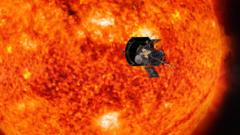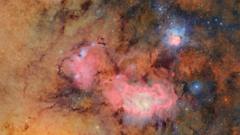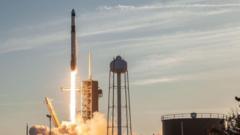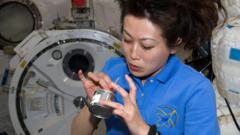NASA's Parker Solar Probe has achieved a groundbreaking milestone, making the closest-ever approach to the Sun at 3.8 million miles during its recent fly-by and collecting vital data about solar mysteries.
NASA's Parker Solar Probe Sets Record with Closest Ever Sun Approach

NASA's Parker Solar Probe Sets Record with Closest Ever Sun Approach
Historic fly-by uncovers secrets of our star's atmosphere
The Parker Solar Probe, a NASA spacecraft, recently made history by successfully navigating the closest-ever approach to the Sun, while withstanding extreme heat and radiation. After several days of silence during its daring fly-by, scientists received confirmation late Thursday that the probe was safe and functioning normally. This record-breaking event saw the spacecraft sail just 3.8 million miles (6.1 million kilometers) from the Sun’s surface, a significant milestone in its mission launched back in 2018.
On Christmas Eve, the probe ventured into the infernal outer atmosphere of the Sun, known as the corona, where temperatures soared to about 1,800°F (980°C). According to NASA, the Parker Solar Probe traveled at astonishing speeds of up to 430,000 mph (692,000 kph), an unprecedented feat for any human-made object. During its brief encounter with the Sun, the probe aimed to gather insights into various solar phenomena, including how the corona can reach millions of degrees while the Sun’s surface is significantly cooler.
NASA scientists were eager for data that would illuminate long-standing questions regarding solar mechanics. Dr. Nicola Fox, head of science at NASA, emphasized that true understanding of the Sun's atmosphere requires a firsthand visit, noting that centuries of solar studies had yet to provide the necessary experiential data. Amid a wave of anticipation, NASA awaited the spacecraft's signal, with anxious moments realized once communication was re-established.
The Parker Solar Probe's thick carbon-composite shield, measuring 4.5 inches, played a crucial role in protecting its sensitive electronics from intense radiation. Dr. Jenifer Millard, an astronomer at Fifth Star Labs, explained that one of the central enigmas the mission hopes to address is the inexplicably high temperature of the corona. Despite being further from the primary heat source of the Sun, the corona reaches scorching temperatures, presenting an intriguing mystery for scientists.
Additionally, the mission aims to deepen our understanding of solar winds, which are streams of charged particles emanating from the corona. These particles contribute to phenomena such as the stunning auroras on Earth, but they can also pose hazards to modern electronic systems and power grids—a crucial consideration in our increasingly tech-driven world.
As the spacecraft moves forward in its exploration of the Sun, NASA remains optimistic that it will lead to discoveries that could have a substantial impact on understanding solar behavior and its effects on Earth. Dr. Millard highlighted the importance of deciphering solar activity for our daily lives, reiterating the mission’s relevance to understanding the intricate relationship between the Sun and Earth.
With its mission well underway, the Parker Solar Probe is set to continue its trailblazing research, providing vital data that could change our comprehension of our solar system's star—and the universe at large.
On Christmas Eve, the probe ventured into the infernal outer atmosphere of the Sun, known as the corona, where temperatures soared to about 1,800°F (980°C). According to NASA, the Parker Solar Probe traveled at astonishing speeds of up to 430,000 mph (692,000 kph), an unprecedented feat for any human-made object. During its brief encounter with the Sun, the probe aimed to gather insights into various solar phenomena, including how the corona can reach millions of degrees while the Sun’s surface is significantly cooler.
NASA scientists were eager for data that would illuminate long-standing questions regarding solar mechanics. Dr. Nicola Fox, head of science at NASA, emphasized that true understanding of the Sun's atmosphere requires a firsthand visit, noting that centuries of solar studies had yet to provide the necessary experiential data. Amid a wave of anticipation, NASA awaited the spacecraft's signal, with anxious moments realized once communication was re-established.
The Parker Solar Probe's thick carbon-composite shield, measuring 4.5 inches, played a crucial role in protecting its sensitive electronics from intense radiation. Dr. Jenifer Millard, an astronomer at Fifth Star Labs, explained that one of the central enigmas the mission hopes to address is the inexplicably high temperature of the corona. Despite being further from the primary heat source of the Sun, the corona reaches scorching temperatures, presenting an intriguing mystery for scientists.
Additionally, the mission aims to deepen our understanding of solar winds, which are streams of charged particles emanating from the corona. These particles contribute to phenomena such as the stunning auroras on Earth, but they can also pose hazards to modern electronic systems and power grids—a crucial consideration in our increasingly tech-driven world.
As the spacecraft moves forward in its exploration of the Sun, NASA remains optimistic that it will lead to discoveries that could have a substantial impact on understanding solar behavior and its effects on Earth. Dr. Millard highlighted the importance of deciphering solar activity for our daily lives, reiterating the mission’s relevance to understanding the intricate relationship between the Sun and Earth.
With its mission well underway, the Parker Solar Probe is set to continue its trailblazing research, providing vital data that could change our comprehension of our solar system's star—and the universe at large.



















